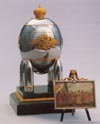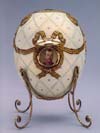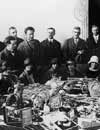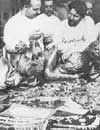Faberge Imperial Easter Eggs
www.Gatchino.com/Jeweller/Faberge/

FabergeImperialEasterEggs
Императорские пасхальные яйца Фаберже
History of Faberge
But Faberge remained loyal to the Imperial Family as well as he was
completely devoted to his country. Faberge was a great patriot.
 He could have made a lot of money during the war, but instead of that he turned
his Moscow shop into a factory to produce ammunition. He had endless
military commissions which he was unable to fulfill, but somehow, Faberge
still managed to make Imperial Eggs for the Tsar and his family. With
minimal recourses and only a few craftsmen he managed to create the
Steel Military Egg for Nicholas II to give Alexandra on 1916 Easter
morning. Faberge mirrored the height of the war in this particular egg
by making the shell of silver which was very much in contrast to the
other eggs.
He could have made a lot of money during the war, but instead of that he turned
his Moscow shop into a factory to produce ammunition. He had endless
military commissions which he was unable to fulfill, but somehow, Faberge
still managed to make Imperial Eggs for the Tsar and his family. With
minimal recourses and only a few craftsmen he managed to create the
Steel Military Egg for Nicholas II to give Alexandra on 1916 Easter
morning. Faberge mirrored the height of the war in this particular egg
by making the shell of silver which was very much in contrast to the
other eggs.
That same year Nicholas II gave his mother Order of St. George Egg. She in return wrote this thank you note to her son:
Unfortunately, success was not part of Nicholas’s future. In 1917, he was forced to abdicate the throne. The Tsar and his family were placed under house-arrest and in April 1918, the revolutionaries moved them to Ekaterinburg, in Siberia. On 17 July, just after midnight, the Tsar, his family, and their faithful servants were awakened from their sleep, brought downstairs into basement and brutally slaughtered. Imperial Russia had ceased to exist.
The Murder of Russia's Imperial Family - "Убийство царской семьи". Соколов Николай Алексеевич. "The Murder of Russia's Imperial Family". Расследование убийства Царской Семьи в 1918 году. Investigation of murder of the Russian imperial family in 1918.
Faberge himself closed his shop during these dramatic days, basically as soon as rumors of the murder of the Imperial Family came to his ears. All world to Faberge was gone together with the Imperial Russia. There was no more reason for Faberge to remain in Russia. He had been the Tsar’s imperial jeweler. Once bolsheviks took control, Faberge was forced to leave his beloved country without his family and without his personal belongings.
The stress of separation and worry about the fate of the rest of his family took their roll on Carl Faberge, causing him to fall seriously ill. In 1920, Faberge was accompanied to Switzerland, where part of his family had already taken refuge. Carl never recovered from the shock of the tragedy that had befallen Russia, the Imperial Family and the House of Faberge.

Carl Faberge died on September 24, 1920 at the age of 74 and those who knew him said that he died from a broken heart.
While revolution and communism destroyed the Tsar of Russia and three hundred years of monarchic reign, FabergEis delicate and fragile creations survived. Revolution changed Russia that FabergE had known and loved. Communists set out to destroy everything once associated with tsarism. Most of imperial treasures were melted down and recycled at the mint. But FabergEis creations were speared from destruction. The newly formed Soviet Union needed hard cash to rebuild the country that had been devastated by years of war.
In the beginning of 1928 the Soviet Union stretched out to the West trying to find buyers for all these imperial treasures. American and European art dealers jumped at the chance to purchase FabergE. In 1930 and 1933, fourteen of the Imperial Easter Eggs were officially sold by Antikvariat, the new government bureau established in 1921 to sell State treasures to the West.

While revolution and communism destroyed the Tsar of Russia and three hundred years of monarchic reign, FabergEis delicate and fragile creations survived. Revolution changed Russia that FabergE had known and loved. Communists set out to destroy everything once associated with tsarism. Most of imperial treasures were melted down and recycled at the mint. But FabergEis creations were speared from destruction. The newly formed Soviet Union needed hard cash to rebuild the country that had been devastated by years of war.
In the beginning of 1928 the Soviet Union stretched out to the West trying to find buyers for all these imperial treasures. American and European art dealers jumped at the chance to purchase FabergE. In 1930 and 1933, fourteen of the Imperial Easter Eggs were officially sold by Antikvariat, the new government bureau established in 1921 to sell State treasures to the West.

In the beginning of 1928 the Soviet Union stretched out to the West trying to find buyers for all these imperial treasures. American and European art dealers jumped at the chance to purchase FabergE. In 1930 and 1933, fourteen of the Imperial Easter Eggs were officially sold by Antikvariat, the new government bureau established in 1921 to sell State treasures to the West.

Peter Carl Faberge was the supreme craftsman of his era, perhaps any era. As master designer to the Imperial Russian Court, he fashioned exquisite works of art. Masterpieces so rare and ingenious in their design that his fame spread through out the world. Peter Carl Faberge became a legend in his own time.
Today, the Faberge legend lives on in a new collection that still represents the work of the most skilled craftsmen, the finest quality materials and the highest and most noble traditions of the European applied arts.
© IMPERIAL COURT INC.